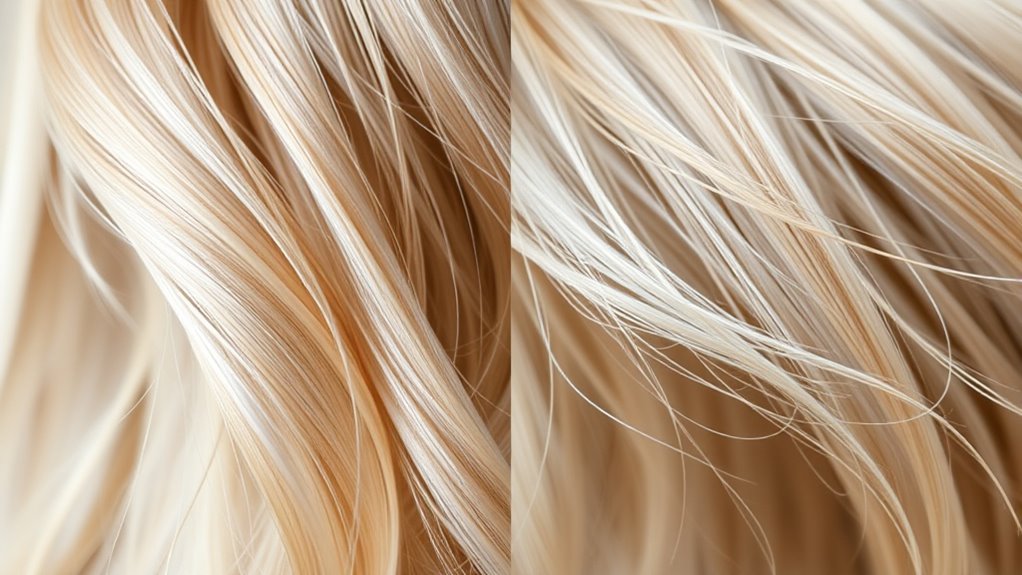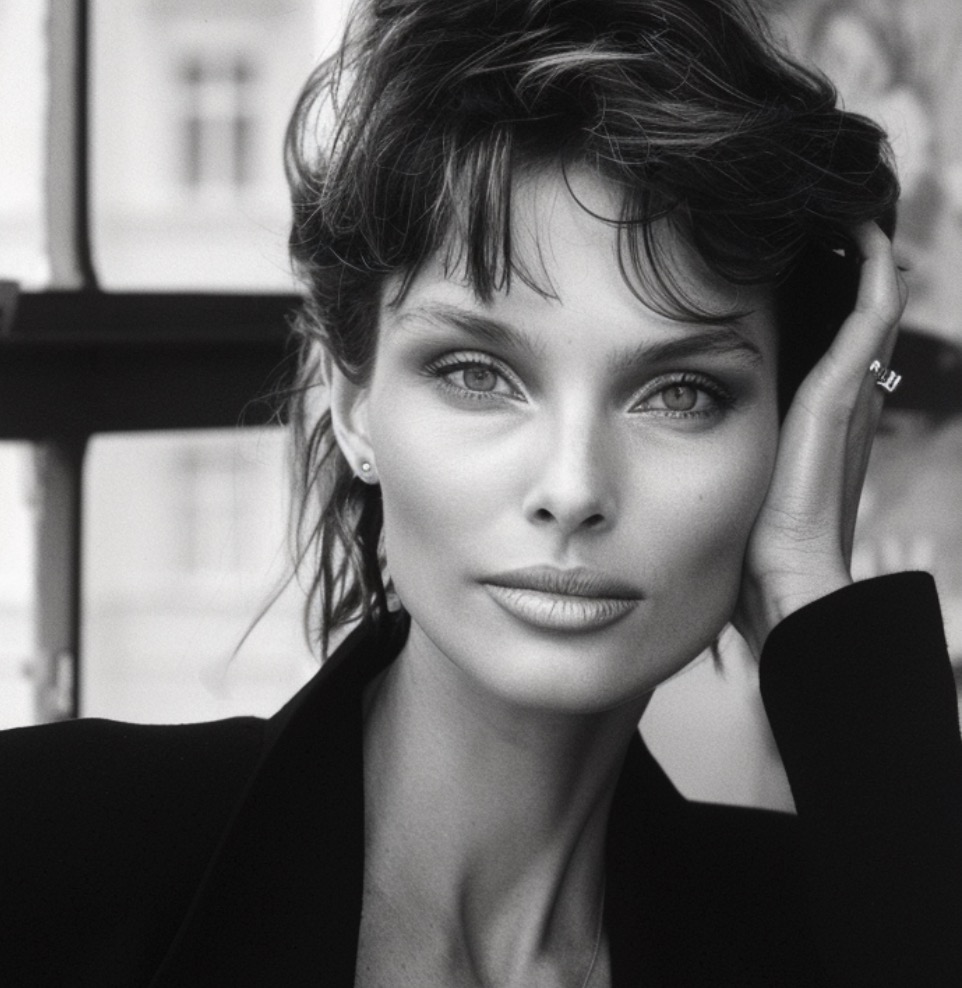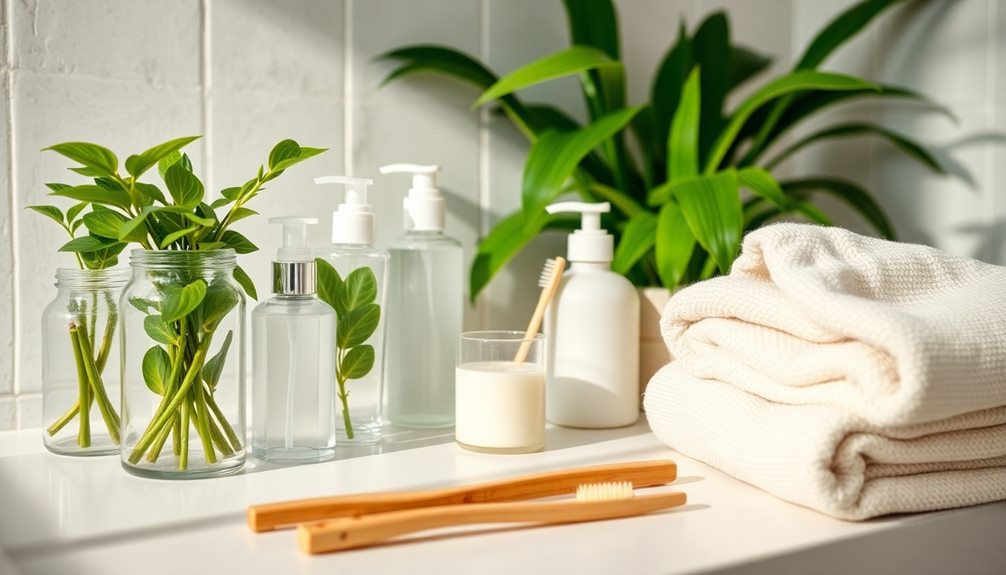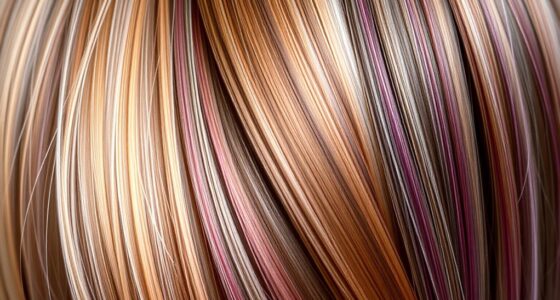Fine hair refers to the thickness of individual strands, which are thin but can be dense, giving a full appearance. Thin hair, on the other hand, relates to the overall volume and number of strands on your scalp, which might look sparse even if each strand isn’t fine. Understanding this difference helps you choose the right products and care routines. Keep exploring, and you’ll discover how to enhance your hair’s health and volume effectively.
Key Takeaways
- Fine hair refers to the thickness of individual strands, while thin hair describes the overall density or number of strands on the scalp.
- Fine hair can be dense, creating volume, whereas thin hair often has fewer strands, leading to a less full appearance.
- A person can have fine, dense hair or coarse, sparse hair; they are distinct characteristics.
- Scalp health impacts hair density and overall appearance, regardless of strand thickness.
- Choosing proper hair care depends on understanding whether hair is fine or thin to maintain volume and health.
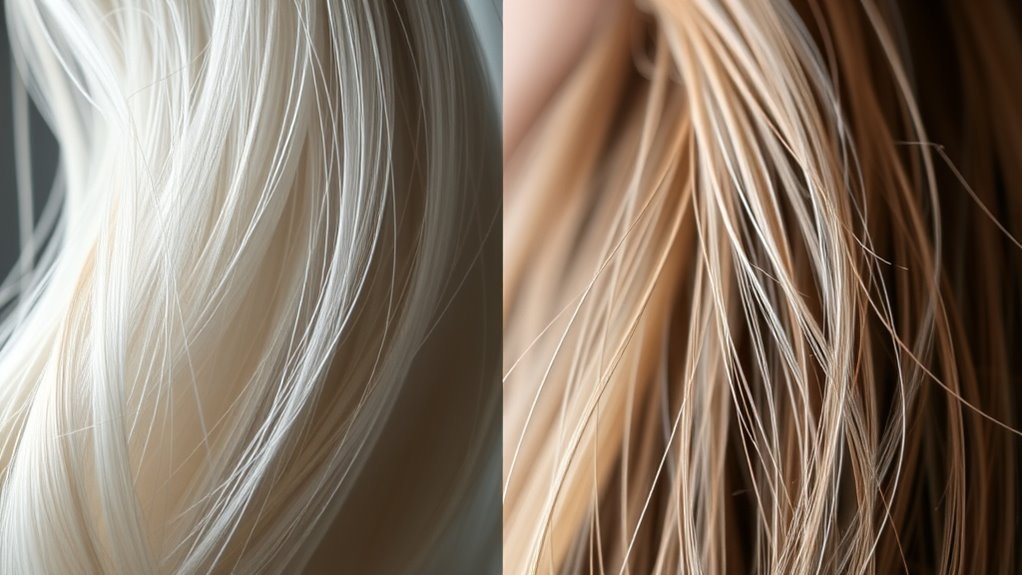
Have you ever wondered what truly sets fine hair apart from thin hair? The answer lies in understanding the difference between hair density and the individual qualities of your hair strands. Fine hair refers to the diameter of each strand—it’s thinner in width compared to other hair types. Thin hair, on the other hand, describes the overall volume or number of hair strands you have on your scalp. You might have fine hair that’s densely packed, giving the illusion of fullness, or you could have coarse hair that’s sparse, making your scalp more visible. Recognizing this distinction can help you better care for your hair and choose the right products.
Understanding the difference between fine and thin hair helps you choose better hair care strategies.
Hair density plays a significant role in how thick or thin your hair appears. If you have high hair density, your scalp is covered with many hair strands, regardless of their thickness. Conversely, low density results in fewer strands, making your scalp easier to see even if each strand is fine or thick. It’s important to note that someone with fine hair can often have high density, which provides volume and a lush look, while someone with coarse hair might have low density, leading to a thinner appearance overall. Your scalp health directly influences this, as a healthy scalp promotes strong, resilient hair growth. Poor scalp health—caused by issues like dryness, excess oil, or inflammation—can weaken hair follicles, leading to shedding and a decrease in overall hair density. Additionally, understanding the difference between hair density and hair quality can guide you in choosing suitable hair care routines and products.
Taking care of your scalp is essential. A clean, balanced scalp encourages healthy hair growth and helps maintain or improve hair density. Regular scalp massages stimulate circulation, bringing nutrients to hair follicles, while using gentle shampoos prevents buildup that can clog follicles. If your scalp isn’t healthy, you might notice more hair shedding or thinning, which affects not just how much hair you have but also how fine or thick each strand feels. Proper scalp care also involves avoiding harsh chemicals or excessive heat styling, which can damage hair strands and weaken the roots over time.
Understanding that fine hair isn’t necessarily thin, and vice versa, empowers you to tailor your hair care routine. Focus on maintaining scalp health through proper hygiene, nourishing treatments, and gentle handling. This approach supports your hair’s overall density and strength, helping you achieve a fuller, healthier look. Whether your concern is adding volume or preventing thinning, knowing the difference between fine and thin hair allows you to make more informed decisions, ensuring your hair remains vibrant and resilient over time.
Frequently Asked Questions
Can Fine Hair Be Thick in Texture?
Yes, fine hair can be thick in texture. Hair texture refers to the individual strand’s thickness, which can be coarse, medium, or fine. If you have fine hair but notice it feels dense or voluminous, it means your hair has a thick or coarse texture. This combination can give your hair a full appearance, even if the strands are thin. Proper styling and products can enhance your hair volume and texture.
Do Thin Hair Strands Grow Faster Than Thick Ones?
You might find that thin hair strands grow slightly faster than thick ones, as hair growth rates are more influenced by genetics and health than strand thickness. On average, hair grows about half an inch per month, regardless of thickness. Notably, thinner strands can give the illusion of quicker growth, but in reality, all hair strands follow similar growth cycles. Your overall hair health impacts how fast your hair appears to grow.
Is Fine Hair More Prone to Damage Than Thin Hair?
Yes, fine hair is more prone to damage due to its hair fragility. Because the strands are thinner and weaker, they break more easily from styling challenges like heat and harsh products. You need to handle fine hair gently, avoid excessive heat, and use nourishing treatments to prevent damage. Proper care helps strengthen your hair and reduces breakage, keeping it healthier and more resilient over time.
Can Hair Density Change Over Time?
Think of your hair density as a garden that can grow or shrink over time. Yes, it can change due to factors like age, health, or hair loss. Don’t believe hair density myths that suggest it’s static—your scalp health and lifestyle choices play a big role. You can improve or maintain your density by caring for your scalp and addressing issues early, keeping your hair garden lush and vibrant.
Are There Specific Products for Fine Versus Thin Hair?
Yes, there are specific products for fine versus thin hair. You should look for styling solutions and products designed to enhance volume and add lift without weighing your hair down. Pay attention to product compatibility, such as lightweight mousses or sprays that boost body. Choosing the right products helps you achieve better results, whether you’re aiming for fuller-looking hair or easier styling, tailored to your hair’s unique needs.
Conclusion
So, now you see, understanding whether your hair is fine or thin isn’t just a small detail—it’s the key to unblocking the secret to flawless styling and healthy hair. Imagine the universe aligning perfectly, your hair transforming into a majestic crown that defies gravity and logic. By knowing the difference, you hold the power to conquer bad hair days and release your true hair potential. It’s not just hair—it’s your personal crown waiting to shine!
